Detailed Report on Teaching, Learning, and Assessment Strategies
VerifiedAdded on 2020/06/04
|22
|6778
|60
Report
AI Summary
This report provides a detailed analysis of teaching, learning, and assessment strategies. It emphasizes the importance of promoting appropriate behavior, respect, and equality among students, alongside establishing a safe and inclusive learning environment. The report outlines points of referral to meet learner requirements, including organizational systems and external agencies. It also discusses the significance of identifying individual learner needs through initial and diagnostic assessments, utilizing methods such as CV reviews, interviews, and application forms. Furthermore, the report delves into setting individual learning goals, planning teaching strategies, and assessing the effectiveness of assessment methods in meeting student needs. Various communication methods used by tutors, along with their advantages and disadvantages, are also explored, culminating in a comprehensive overview of effective teaching and learning practices.
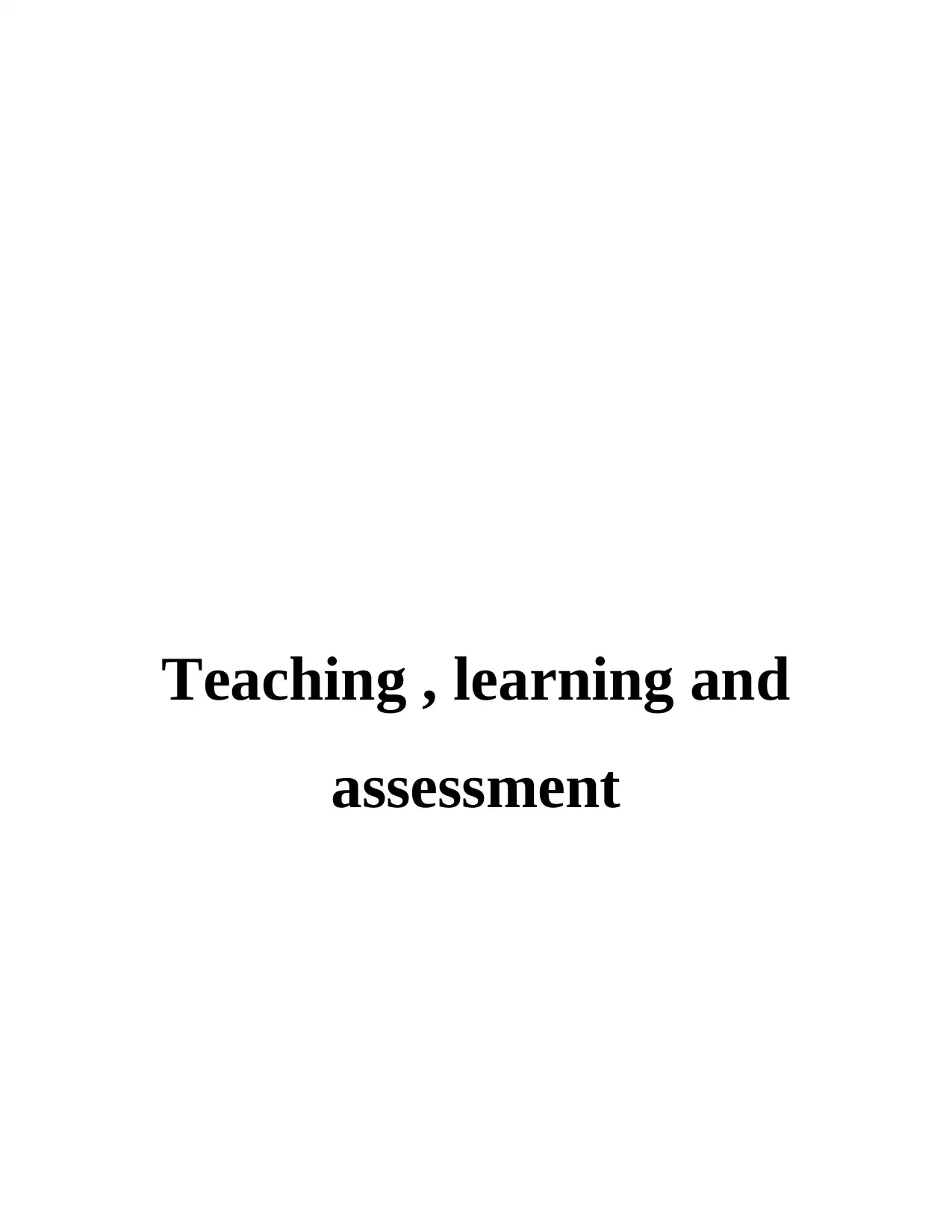
Teaching , learning and
assessment
assessment
Paraphrase This Document
Need a fresh take? Get an instant paraphrase of this document with our AI Paraphraser
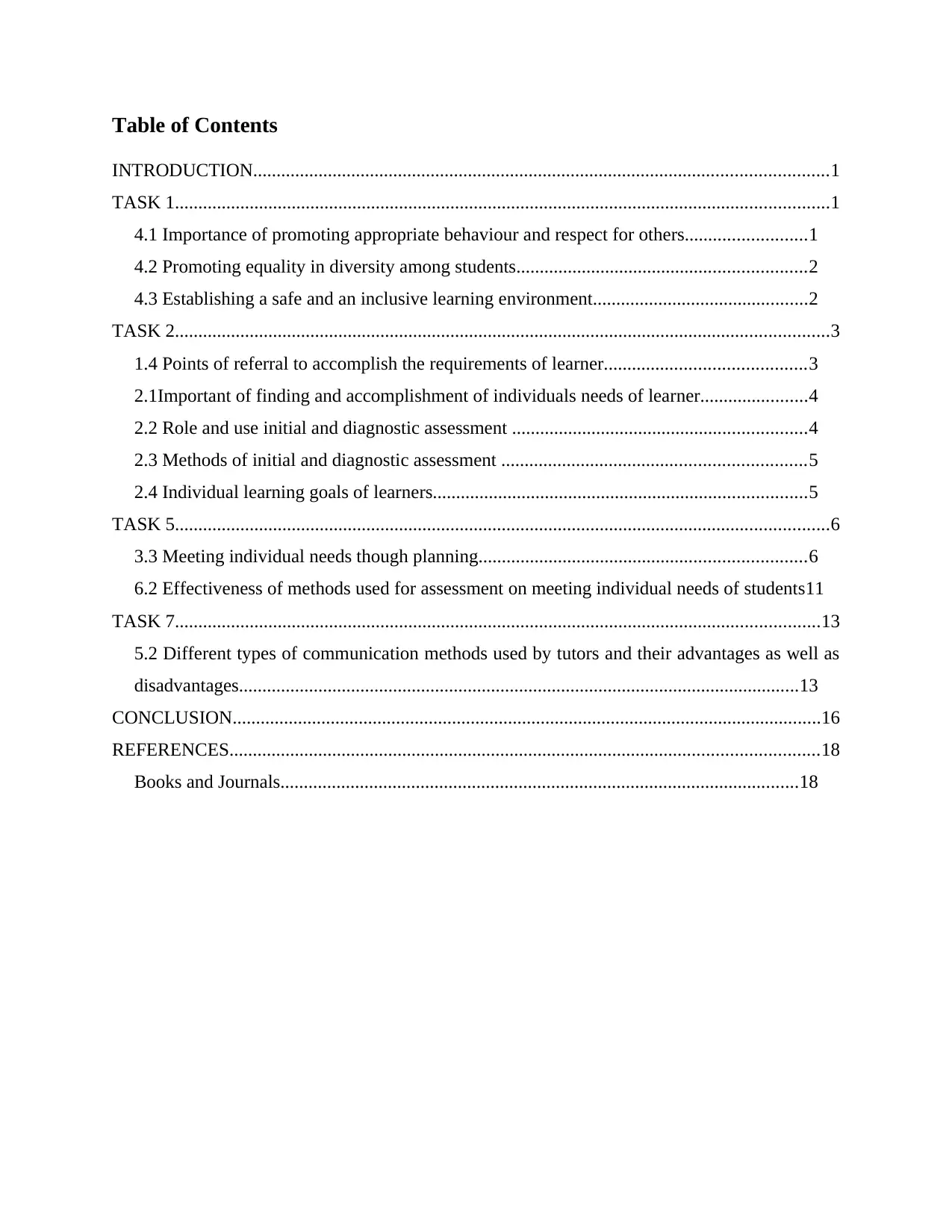
Table of Contents
INTRODUCTION...........................................................................................................................1
TASK 1............................................................................................................................................1
4.1 Importance of promoting appropriate behaviour and respect for others..........................1
4.2 Promoting equality in diversity among students..............................................................2
4.3 Establishing a safe and an inclusive learning environment..............................................2
TASK 2............................................................................................................................................3
1.4 Points of referral to accomplish the requirements of learner...........................................3
2.1Important of finding and accomplishment of individuals needs of learner.......................4
2.2 Role and use initial and diagnostic assessment ...............................................................4
2.3 Methods of initial and diagnostic assessment .................................................................5
2.4 Individual learning goals of learners................................................................................5
TASK 5............................................................................................................................................6
3.3 Meeting individual needs though planning......................................................................6
6.2 Effectiveness of methods used for assessment on meeting individual needs of students11
TASK 7..........................................................................................................................................13
5.2 Different types of communication methods used by tutors and their advantages as well as
disadvantages........................................................................................................................13
CONCLUSION..............................................................................................................................16
REFERENCES..............................................................................................................................18
Books and Journals...............................................................................................................18
INTRODUCTION...........................................................................................................................1
TASK 1............................................................................................................................................1
4.1 Importance of promoting appropriate behaviour and respect for others..........................1
4.2 Promoting equality in diversity among students..............................................................2
4.3 Establishing a safe and an inclusive learning environment..............................................2
TASK 2............................................................................................................................................3
1.4 Points of referral to accomplish the requirements of learner...........................................3
2.1Important of finding and accomplishment of individuals needs of learner.......................4
2.2 Role and use initial and diagnostic assessment ...............................................................4
2.3 Methods of initial and diagnostic assessment .................................................................5
2.4 Individual learning goals of learners................................................................................5
TASK 5............................................................................................................................................6
3.3 Meeting individual needs though planning......................................................................6
6.2 Effectiveness of methods used for assessment on meeting individual needs of students11
TASK 7..........................................................................................................................................13
5.2 Different types of communication methods used by tutors and their advantages as well as
disadvantages........................................................................................................................13
CONCLUSION..............................................................................................................................16
REFERENCES..............................................................................................................................18
Books and Journals...............................................................................................................18
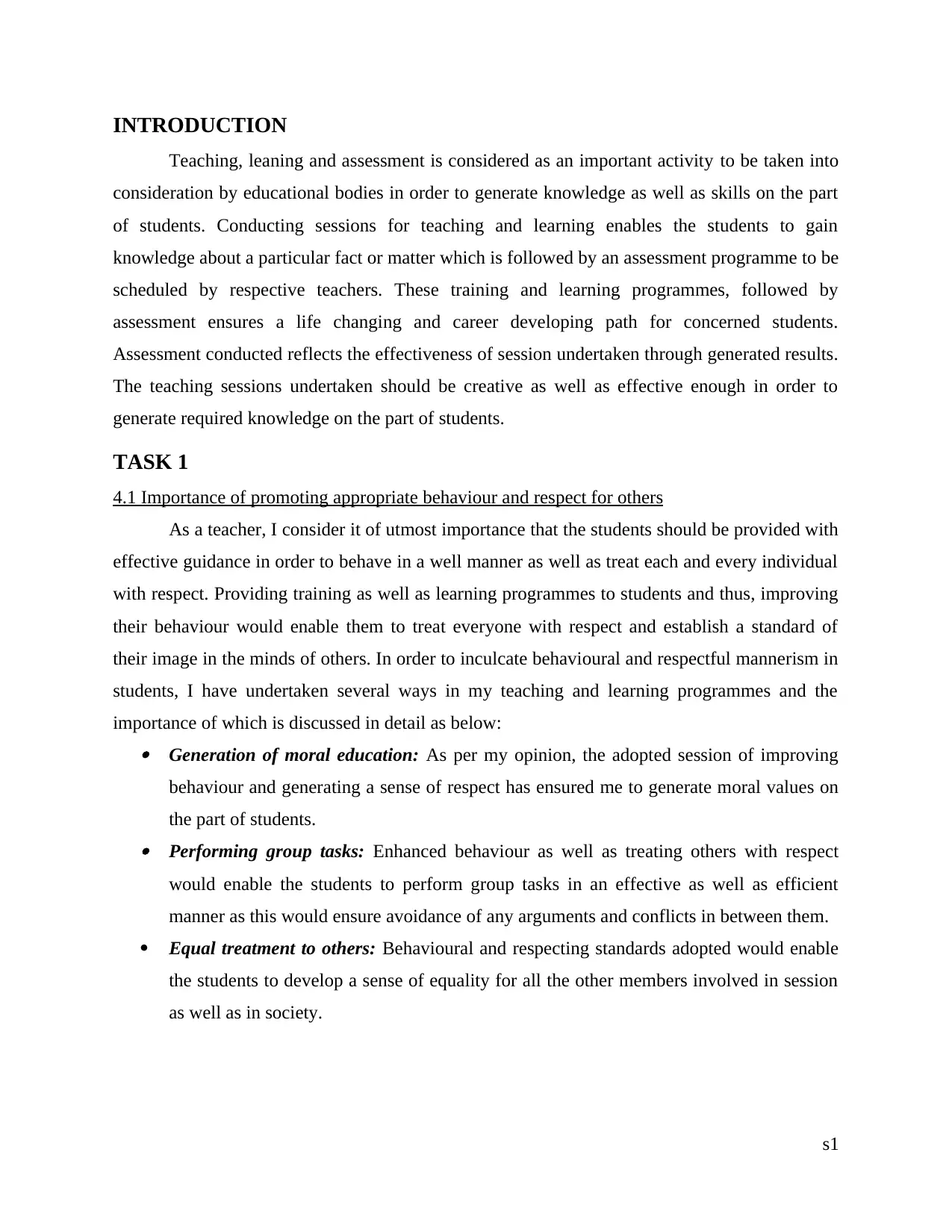
INTRODUCTION
Teaching, leaning and assessment is considered as an important activity to be taken into
consideration by educational bodies in order to generate knowledge as well as skills on the part
of students. Conducting sessions for teaching and learning enables the students to gain
knowledge about a particular fact or matter which is followed by an assessment programme to be
scheduled by respective teachers. These training and learning programmes, followed by
assessment ensures a life changing and career developing path for concerned students.
Assessment conducted reflects the effectiveness of session undertaken through generated results.
The teaching sessions undertaken should be creative as well as effective enough in order to
generate required knowledge on the part of students.
TASK 1
4.1 Importance of promoting appropriate behaviour and respect for others
As a teacher, I consider it of utmost importance that the students should be provided with
effective guidance in order to behave in a well manner as well as treat each and every individual
with respect. Providing training as well as learning programmes to students and thus, improving
their behaviour would enable them to treat everyone with respect and establish a standard of
their image in the minds of others. In order to inculcate behavioural and respectful mannerism in
students, I have undertaken several ways in my teaching and learning programmes and the
importance of which is discussed in detail as below: Generation of moral education: As per my opinion, the adopted session of improving
behaviour and generating a sense of respect has ensured me to generate moral values on
the part of students. Performing group tasks: Enhanced behaviour as well as treating others with respect
would enable the students to perform group tasks in an effective as well as efficient
manner as this would ensure avoidance of any arguments and conflicts in between them.
Equal treatment to others: Behavioural and respecting standards adopted would enable
the students to develop a sense of equality for all the other members involved in session
as well as in society.
s1
Teaching, leaning and assessment is considered as an important activity to be taken into
consideration by educational bodies in order to generate knowledge as well as skills on the part
of students. Conducting sessions for teaching and learning enables the students to gain
knowledge about a particular fact or matter which is followed by an assessment programme to be
scheduled by respective teachers. These training and learning programmes, followed by
assessment ensures a life changing and career developing path for concerned students.
Assessment conducted reflects the effectiveness of session undertaken through generated results.
The teaching sessions undertaken should be creative as well as effective enough in order to
generate required knowledge on the part of students.
TASK 1
4.1 Importance of promoting appropriate behaviour and respect for others
As a teacher, I consider it of utmost importance that the students should be provided with
effective guidance in order to behave in a well manner as well as treat each and every individual
with respect. Providing training as well as learning programmes to students and thus, improving
their behaviour would enable them to treat everyone with respect and establish a standard of
their image in the minds of others. In order to inculcate behavioural and respectful mannerism in
students, I have undertaken several ways in my teaching and learning programmes and the
importance of which is discussed in detail as below: Generation of moral education: As per my opinion, the adopted session of improving
behaviour and generating a sense of respect has ensured me to generate moral values on
the part of students. Performing group tasks: Enhanced behaviour as well as treating others with respect
would enable the students to perform group tasks in an effective as well as efficient
manner as this would ensure avoidance of any arguments and conflicts in between them.
Equal treatment to others: Behavioural and respecting standards adopted would enable
the students to develop a sense of equality for all the other members involved in session
as well as in society.
s1
⊘ This is a preview!⊘
Do you want full access?
Subscribe today to unlock all pages.

Trusted by 1+ million students worldwide
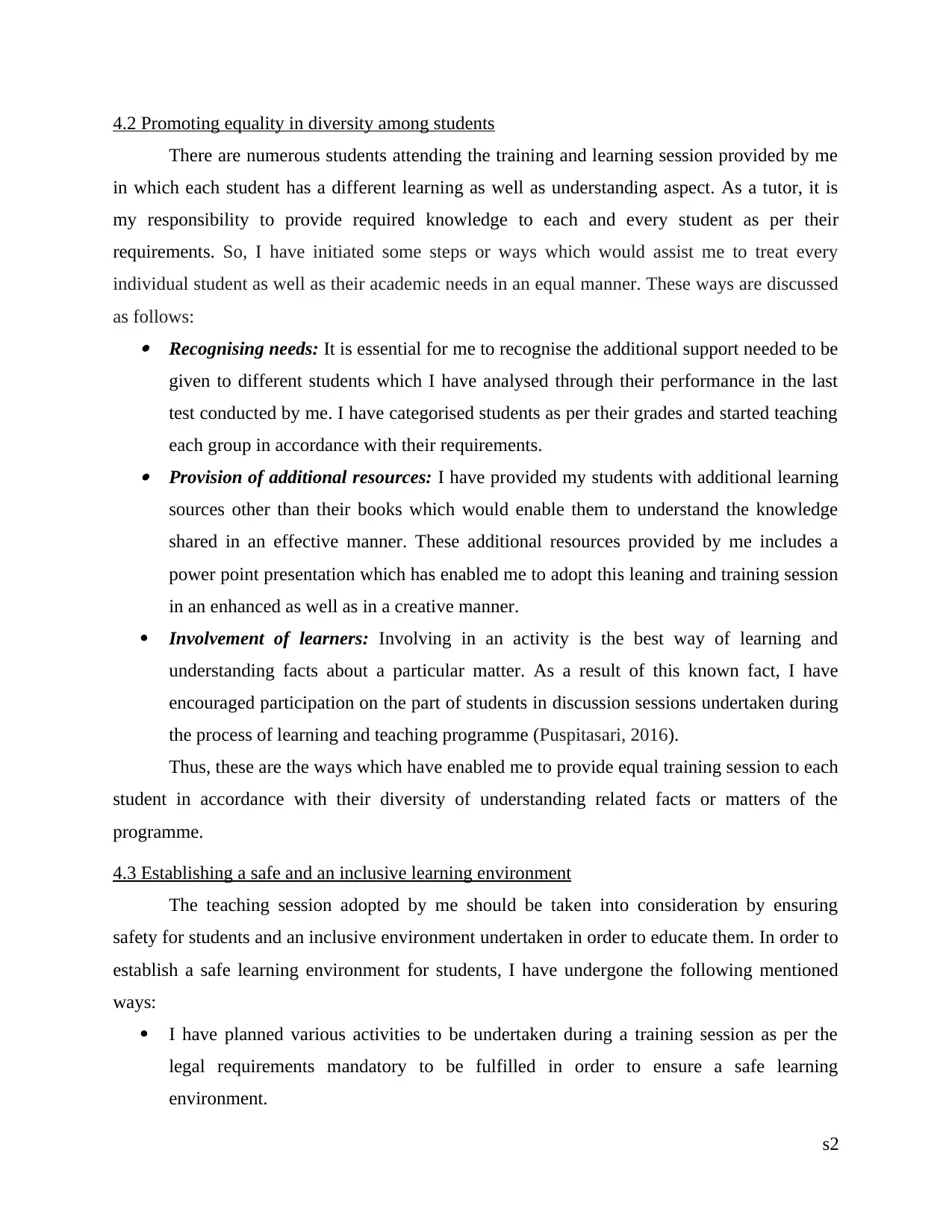
4.2 Promoting equality in diversity among students
There are numerous students attending the training and learning session provided by me
in which each student has a different learning as well as understanding aspect. As a tutor, it is
my responsibility to provide required knowledge to each and every student as per their
requirements. So, I have initiated some steps or ways which would assist me to treat every
individual student as well as their academic needs in an equal manner. These ways are discussed
as follows: Recognising needs: It is essential for me to recognise the additional support needed to be
given to different students which I have analysed through their performance in the last
test conducted by me. I have categorised students as per their grades and started teaching
each group in accordance with their requirements. Provision of additional resources: I have provided my students with additional learning
sources other than their books which would enable them to understand the knowledge
shared in an effective manner. These additional resources provided by me includes a
power point presentation which has enabled me to adopt this leaning and training session
in an enhanced as well as in a creative manner.
Involvement of learners: Involving in an activity is the best way of learning and
understanding facts about a particular matter. As a result of this known fact, I have
encouraged participation on the part of students in discussion sessions undertaken during
the process of learning and teaching programme (Puspitasari, 2016).
Thus, these are the ways which have enabled me to provide equal training session to each
student in accordance with their diversity of understanding related facts or matters of the
programme.
4.3 Establishing a safe and an inclusive learning environment
The teaching session adopted by me should be taken into consideration by ensuring
safety for students and an inclusive environment undertaken in order to educate them. In order to
establish a safe learning environment for students, I have undergone the following mentioned
ways:
I have planned various activities to be undertaken during a training session as per the
legal requirements mandatory to be fulfilled in order to ensure a safe learning
environment.
s2
There are numerous students attending the training and learning session provided by me
in which each student has a different learning as well as understanding aspect. As a tutor, it is
my responsibility to provide required knowledge to each and every student as per their
requirements. So, I have initiated some steps or ways which would assist me to treat every
individual student as well as their academic needs in an equal manner. These ways are discussed
as follows: Recognising needs: It is essential for me to recognise the additional support needed to be
given to different students which I have analysed through their performance in the last
test conducted by me. I have categorised students as per their grades and started teaching
each group in accordance with their requirements. Provision of additional resources: I have provided my students with additional learning
sources other than their books which would enable them to understand the knowledge
shared in an effective manner. These additional resources provided by me includes a
power point presentation which has enabled me to adopt this leaning and training session
in an enhanced as well as in a creative manner.
Involvement of learners: Involving in an activity is the best way of learning and
understanding facts about a particular matter. As a result of this known fact, I have
encouraged participation on the part of students in discussion sessions undertaken during
the process of learning and teaching programme (Puspitasari, 2016).
Thus, these are the ways which have enabled me to provide equal training session to each
student in accordance with their diversity of understanding related facts or matters of the
programme.
4.3 Establishing a safe and an inclusive learning environment
The teaching session adopted by me should be taken into consideration by ensuring
safety for students and an inclusive environment undertaken in order to educate them. In order to
establish a safe learning environment for students, I have undergone the following mentioned
ways:
I have planned various activities to be undertaken during a training session as per the
legal requirements mandatory to be fulfilled in order to ensure a safe learning
environment.
s2
Paraphrase This Document
Need a fresh take? Get an instant paraphrase of this document with our AI Paraphraser
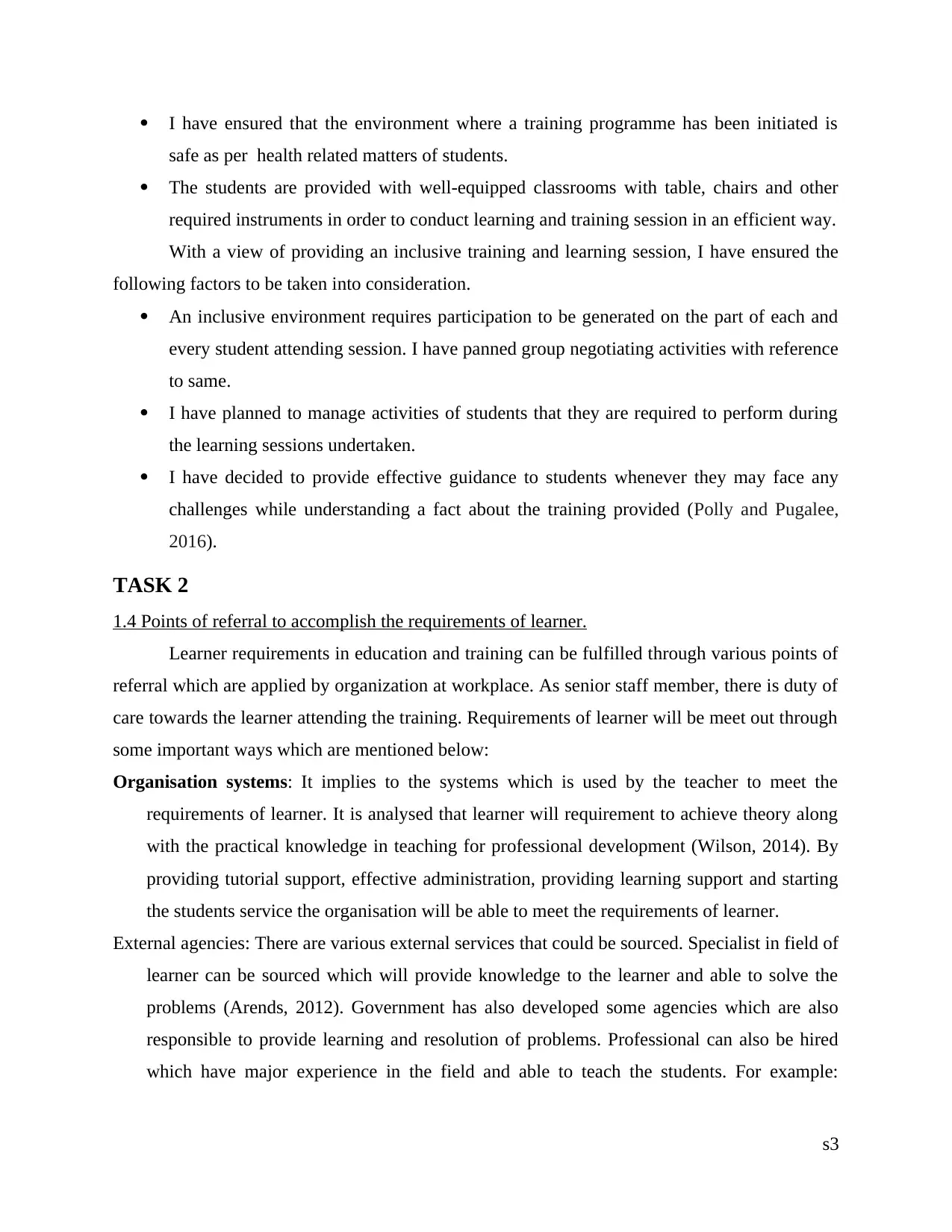
I have ensured that the environment where a training programme has been initiated is
safe as per health related matters of students.
The students are provided with well-equipped classrooms with table, chairs and other
required instruments in order to conduct learning and training session in an efficient way.
With a view of providing an inclusive training and learning session, I have ensured the
following factors to be taken into consideration.
An inclusive environment requires participation to be generated on the part of each and
every student attending session. I have panned group negotiating activities with reference
to same.
I have planned to manage activities of students that they are required to perform during
the learning sessions undertaken.
I have decided to provide effective guidance to students whenever they may face any
challenges while understanding a fact about the training provided (Polly and Pugalee,
2016).
TASK 2
1.4 Points of referral to accomplish the requirements of learner.
Learner requirements in education and training can be fulfilled through various points of
referral which are applied by organization at workplace. As senior staff member, there is duty of
care towards the learner attending the training. Requirements of learner will be meet out through
some important ways which are mentioned below:
Organisation systems: It implies to the systems which is used by the teacher to meet the
requirements of learner. It is analysed that learner will requirement to achieve theory along
with the practical knowledge in teaching for professional development (Wilson, 2014). By
providing tutorial support, effective administration, providing learning support and starting
the students service the organisation will be able to meet the requirements of learner.
External agencies: There are various external services that could be sourced. Specialist in field of
learner can be sourced which will provide knowledge to the learner and able to solve the
problems (Arends, 2012). Government has also developed some agencies which are also
responsible to provide learning and resolution of problems. Professional can also be hired
which have major experience in the field and able to teach the students. For example:
s3
safe as per health related matters of students.
The students are provided with well-equipped classrooms with table, chairs and other
required instruments in order to conduct learning and training session in an efficient way.
With a view of providing an inclusive training and learning session, I have ensured the
following factors to be taken into consideration.
An inclusive environment requires participation to be generated on the part of each and
every student attending session. I have panned group negotiating activities with reference
to same.
I have planned to manage activities of students that they are required to perform during
the learning sessions undertaken.
I have decided to provide effective guidance to students whenever they may face any
challenges while understanding a fact about the training provided (Polly and Pugalee,
2016).
TASK 2
1.4 Points of referral to accomplish the requirements of learner.
Learner requirements in education and training can be fulfilled through various points of
referral which are applied by organization at workplace. As senior staff member, there is duty of
care towards the learner attending the training. Requirements of learner will be meet out through
some important ways which are mentioned below:
Organisation systems: It implies to the systems which is used by the teacher to meet the
requirements of learner. It is analysed that learner will requirement to achieve theory along
with the practical knowledge in teaching for professional development (Wilson, 2014). By
providing tutorial support, effective administration, providing learning support and starting
the students service the organisation will be able to meet the requirements of learner.
External agencies: There are various external services that could be sourced. Specialist in field of
learner can be sourced which will provide knowledge to the learner and able to solve the
problems (Arends, 2012). Government has also developed some agencies which are also
responsible to provide learning and resolution of problems. Professional can also be hired
which have major experience in the field and able to teach the students. For example:
s3
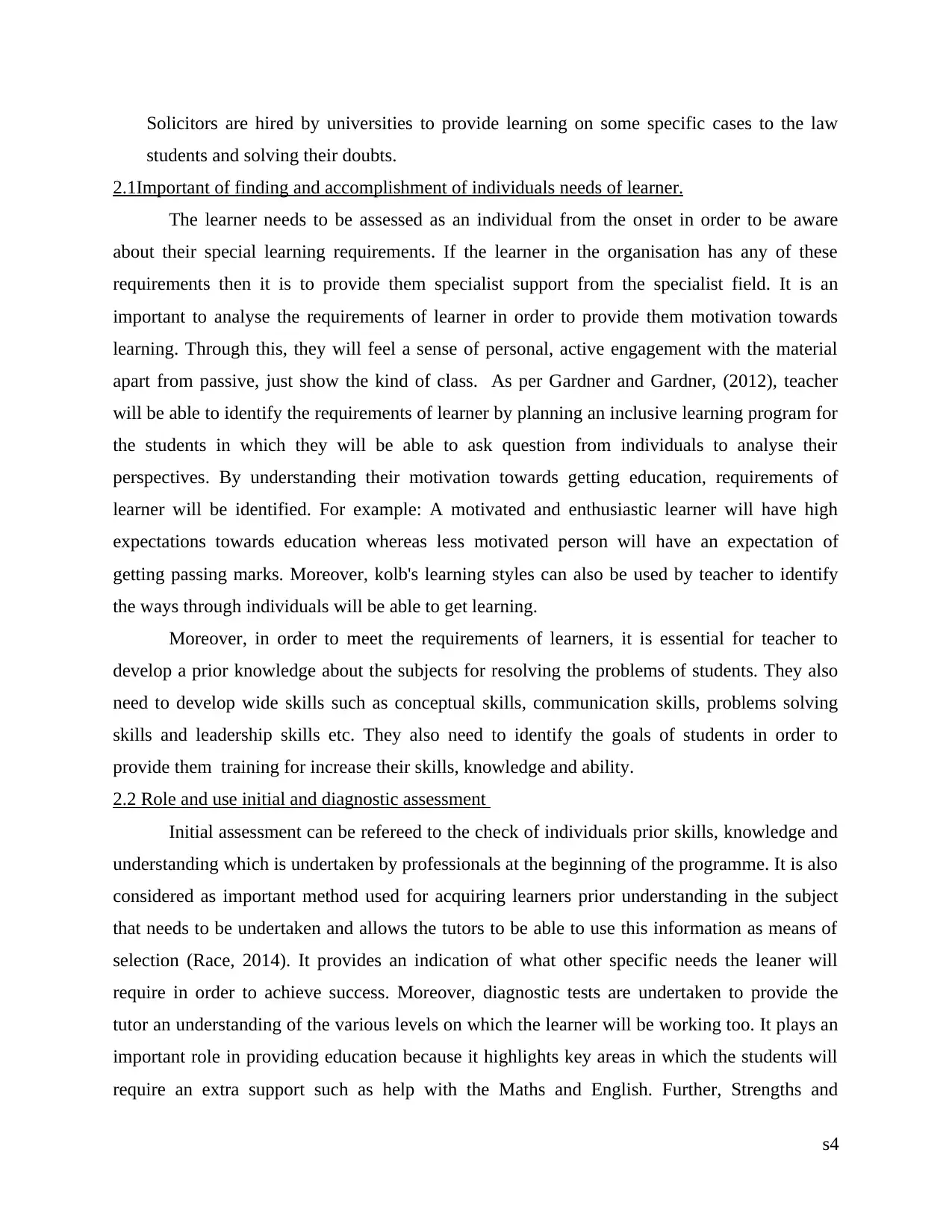
Solicitors are hired by universities to provide learning on some specific cases to the law
students and solving their doubts.
2.1Important of finding and accomplishment of individuals needs of learner.
The learner needs to be assessed as an individual from the onset in order to be aware
about their special learning requirements. If the learner in the organisation has any of these
requirements then it is to provide them specialist support from the specialist field. It is an
important to analyse the requirements of learner in order to provide them motivation towards
learning. Through this, they will feel a sense of personal, active engagement with the material
apart from passive, just show the kind of class. As per Gardner and Gardner, (2012), teacher
will be able to identify the requirements of learner by planning an inclusive learning program for
the students in which they will be able to ask question from individuals to analyse their
perspectives. By understanding their motivation towards getting education, requirements of
learner will be identified. For example: A motivated and enthusiastic learner will have high
expectations towards education whereas less motivated person will have an expectation of
getting passing marks. Moreover, kolb's learning styles can also be used by teacher to identify
the ways through individuals will be able to get learning.
Moreover, in order to meet the requirements of learners, it is essential for teacher to
develop a prior knowledge about the subjects for resolving the problems of students. They also
need to develop wide skills such as conceptual skills, communication skills, problems solving
skills and leadership skills etc. They also need to identify the goals of students in order to
provide them training for increase their skills, knowledge and ability.
2.2 Role and use initial and diagnostic assessment
Initial assessment can be refereed to the check of individuals prior skills, knowledge and
understanding which is undertaken by professionals at the beginning of the programme. It is also
considered as important method used for acquiring learners prior understanding in the subject
that needs to be undertaken and allows the tutors to be able to use this information as means of
selection (Race, 2014). It provides an indication of what other specific needs the leaner will
require in order to achieve success. Moreover, diagnostic tests are undertaken to provide the
tutor an understanding of the various levels on which the learner will be working too. It plays an
important role in providing education because it highlights key areas in which the students will
require an extra support such as help with the Maths and English. Further, Strengths and
s4
students and solving their doubts.
2.1Important of finding and accomplishment of individuals needs of learner.
The learner needs to be assessed as an individual from the onset in order to be aware
about their special learning requirements. If the learner in the organisation has any of these
requirements then it is to provide them specialist support from the specialist field. It is an
important to analyse the requirements of learner in order to provide them motivation towards
learning. Through this, they will feel a sense of personal, active engagement with the material
apart from passive, just show the kind of class. As per Gardner and Gardner, (2012), teacher
will be able to identify the requirements of learner by planning an inclusive learning program for
the students in which they will be able to ask question from individuals to analyse their
perspectives. By understanding their motivation towards getting education, requirements of
learner will be identified. For example: A motivated and enthusiastic learner will have high
expectations towards education whereas less motivated person will have an expectation of
getting passing marks. Moreover, kolb's learning styles can also be used by teacher to identify
the ways through individuals will be able to get learning.
Moreover, in order to meet the requirements of learners, it is essential for teacher to
develop a prior knowledge about the subjects for resolving the problems of students. They also
need to develop wide skills such as conceptual skills, communication skills, problems solving
skills and leadership skills etc. They also need to identify the goals of students in order to
provide them training for increase their skills, knowledge and ability.
2.2 Role and use initial and diagnostic assessment
Initial assessment can be refereed to the check of individuals prior skills, knowledge and
understanding which is undertaken by professionals at the beginning of the programme. It is also
considered as important method used for acquiring learners prior understanding in the subject
that needs to be undertaken and allows the tutors to be able to use this information as means of
selection (Race, 2014). It provides an indication of what other specific needs the leaner will
require in order to achieve success. Moreover, diagnostic tests are undertaken to provide the
tutor an understanding of the various levels on which the learner will be working too. It plays an
important role in providing education because it highlights key areas in which the students will
require an extra support such as help with the Maths and English. Further, Strengths and
s4
⊘ This is a preview!⊘
Do you want full access?
Subscribe today to unlock all pages.

Trusted by 1+ million students worldwide
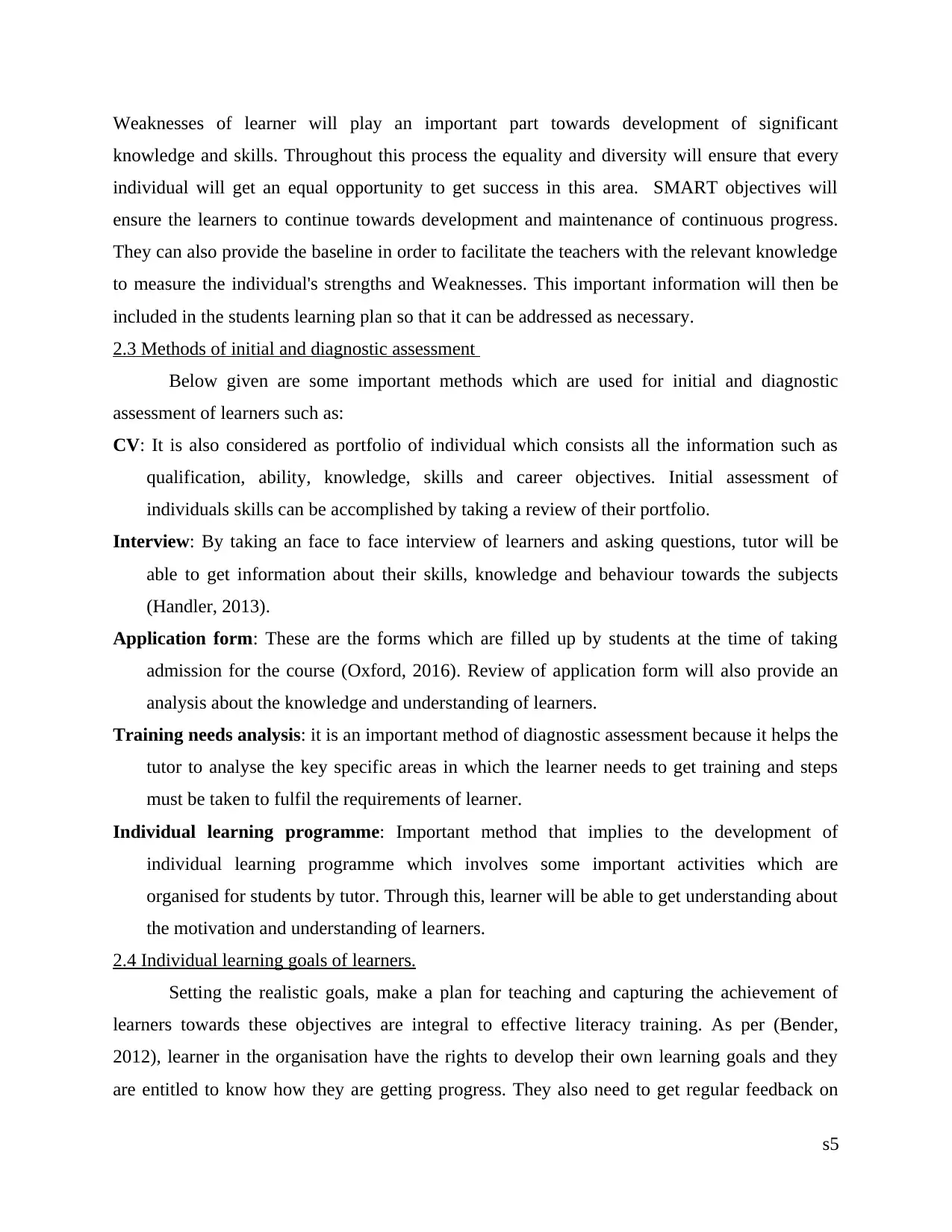
Weaknesses of learner will play an important part towards development of significant
knowledge and skills. Throughout this process the equality and diversity will ensure that every
individual will get an equal opportunity to get success in this area. SMART objectives will
ensure the learners to continue towards development and maintenance of continuous progress.
They can also provide the baseline in order to facilitate the teachers with the relevant knowledge
to measure the individual's strengths and Weaknesses. This important information will then be
included in the students learning plan so that it can be addressed as necessary.
2.3 Methods of initial and diagnostic assessment
Below given are some important methods which are used for initial and diagnostic
assessment of learners such as:
CV: It is also considered as portfolio of individual which consists all the information such as
qualification, ability, knowledge, skills and career objectives. Initial assessment of
individuals skills can be accomplished by taking a review of their portfolio.
Interview: By taking an face to face interview of learners and asking questions, tutor will be
able to get information about their skills, knowledge and behaviour towards the subjects
(Handler, 2013).
Application form: These are the forms which are filled up by students at the time of taking
admission for the course (Oxford, 2016). Review of application form will also provide an
analysis about the knowledge and understanding of learners.
Training needs analysis: it is an important method of diagnostic assessment because it helps the
tutor to analyse the key specific areas in which the learner needs to get training and steps
must be taken to fulfil the requirements of learner.
Individual learning programme: Important method that implies to the development of
individual learning programme which involves some important activities which are
organised for students by tutor. Through this, learner will be able to get understanding about
the motivation and understanding of learners.
2.4 Individual learning goals of learners.
Setting the realistic goals, make a plan for teaching and capturing the achievement of
learners towards these objectives are integral to effective literacy training. As per (Bender,
2012), learner in the organisation have the rights to develop their own learning goals and they
are entitled to know how they are getting progress. They also need to get regular feedback on
s5
knowledge and skills. Throughout this process the equality and diversity will ensure that every
individual will get an equal opportunity to get success in this area. SMART objectives will
ensure the learners to continue towards development and maintenance of continuous progress.
They can also provide the baseline in order to facilitate the teachers with the relevant knowledge
to measure the individual's strengths and Weaknesses. This important information will then be
included in the students learning plan so that it can be addressed as necessary.
2.3 Methods of initial and diagnostic assessment
Below given are some important methods which are used for initial and diagnostic
assessment of learners such as:
CV: It is also considered as portfolio of individual which consists all the information such as
qualification, ability, knowledge, skills and career objectives. Initial assessment of
individuals skills can be accomplished by taking a review of their portfolio.
Interview: By taking an face to face interview of learners and asking questions, tutor will be
able to get information about their skills, knowledge and behaviour towards the subjects
(Handler, 2013).
Application form: These are the forms which are filled up by students at the time of taking
admission for the course (Oxford, 2016). Review of application form will also provide an
analysis about the knowledge and understanding of learners.
Training needs analysis: it is an important method of diagnostic assessment because it helps the
tutor to analyse the key specific areas in which the learner needs to get training and steps
must be taken to fulfil the requirements of learner.
Individual learning programme: Important method that implies to the development of
individual learning programme which involves some important activities which are
organised for students by tutor. Through this, learner will be able to get understanding about
the motivation and understanding of learners.
2.4 Individual learning goals of learners.
Setting the realistic goals, make a plan for teaching and capturing the achievement of
learners towards these objectives are integral to effective literacy training. As per (Bender,
2012), learner in the organisation have the rights to develop their own learning goals and they
are entitled to know how they are getting progress. They also need to get regular feedback on
s5
Paraphrase This Document
Need a fresh take? Get an instant paraphrase of this document with our AI Paraphraser
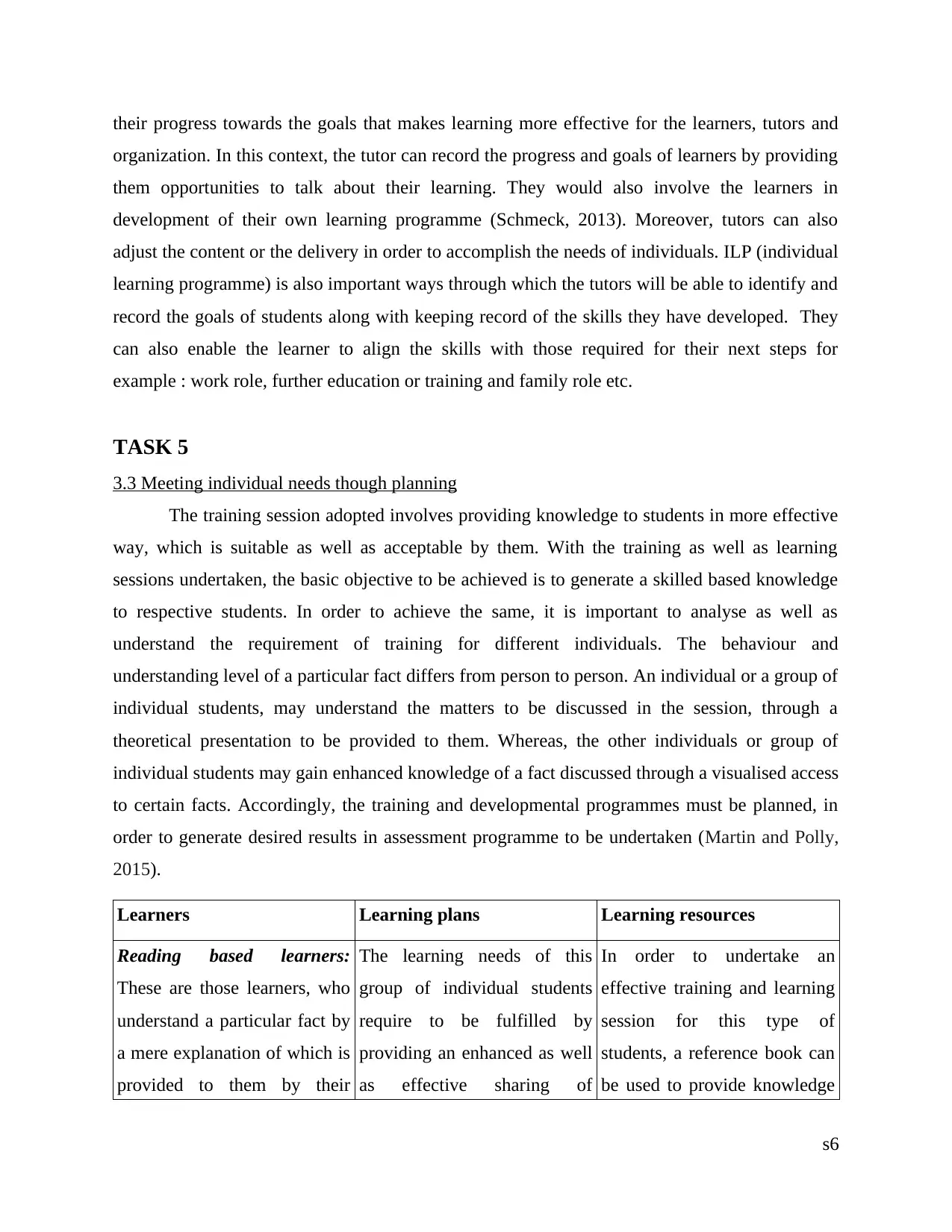
their progress towards the goals that makes learning more effective for the learners, tutors and
organization. In this context, the tutor can record the progress and goals of learners by providing
them opportunities to talk about their learning. They would also involve the learners in
development of their own learning programme (Schmeck, 2013). Moreover, tutors can also
adjust the content or the delivery in order to accomplish the needs of individuals. ILP (individual
learning programme) is also important ways through which the tutors will be able to identify and
record the goals of students along with keeping record of the skills they have developed. They
can also enable the learner to align the skills with those required for their next steps for
example : work role, further education or training and family role etc.
TASK 5
3.3 Meeting individual needs though planning
The training session adopted involves providing knowledge to students in more effective
way, which is suitable as well as acceptable by them. With the training as well as learning
sessions undertaken, the basic objective to be achieved is to generate a skilled based knowledge
to respective students. In order to achieve the same, it is important to analyse as well as
understand the requirement of training for different individuals. The behaviour and
understanding level of a particular fact differs from person to person. An individual or a group of
individual students, may understand the matters to be discussed in the session, through a
theoretical presentation to be provided to them. Whereas, the other individuals or group of
individual students may gain enhanced knowledge of a fact discussed through a visualised access
to certain facts. Accordingly, the training and developmental programmes must be planned, in
order to generate desired results in assessment programme to be undertaken (Martin and Polly,
2015).
Learners Learning plans Learning resources
Reading based learners:
These are those learners, who
understand a particular fact by
a mere explanation of which is
provided to them by their
The learning needs of this
group of individual students
require to be fulfilled by
providing an enhanced as well
as effective sharing of
In order to undertake an
effective training and learning
session for this type of
students, a reference book can
be used to provide knowledge
s6
organization. In this context, the tutor can record the progress and goals of learners by providing
them opportunities to talk about their learning. They would also involve the learners in
development of their own learning programme (Schmeck, 2013). Moreover, tutors can also
adjust the content or the delivery in order to accomplish the needs of individuals. ILP (individual
learning programme) is also important ways through which the tutors will be able to identify and
record the goals of students along with keeping record of the skills they have developed. They
can also enable the learner to align the skills with those required for their next steps for
example : work role, further education or training and family role etc.
TASK 5
3.3 Meeting individual needs though planning
The training session adopted involves providing knowledge to students in more effective
way, which is suitable as well as acceptable by them. With the training as well as learning
sessions undertaken, the basic objective to be achieved is to generate a skilled based knowledge
to respective students. In order to achieve the same, it is important to analyse as well as
understand the requirement of training for different individuals. The behaviour and
understanding level of a particular fact differs from person to person. An individual or a group of
individual students, may understand the matters to be discussed in the session, through a
theoretical presentation to be provided to them. Whereas, the other individuals or group of
individual students may gain enhanced knowledge of a fact discussed through a visualised access
to certain facts. Accordingly, the training and developmental programmes must be planned, in
order to generate desired results in assessment programme to be undertaken (Martin and Polly,
2015).
Learners Learning plans Learning resources
Reading based learners:
These are those learners, who
understand a particular fact by
a mere explanation of which is
provided to them by their
The learning needs of this
group of individual students
require to be fulfilled by
providing an enhanced as well
as effective sharing of
In order to undertake an
effective training and learning
session for this type of
students, a reference book can
be used to provide knowledge
s6
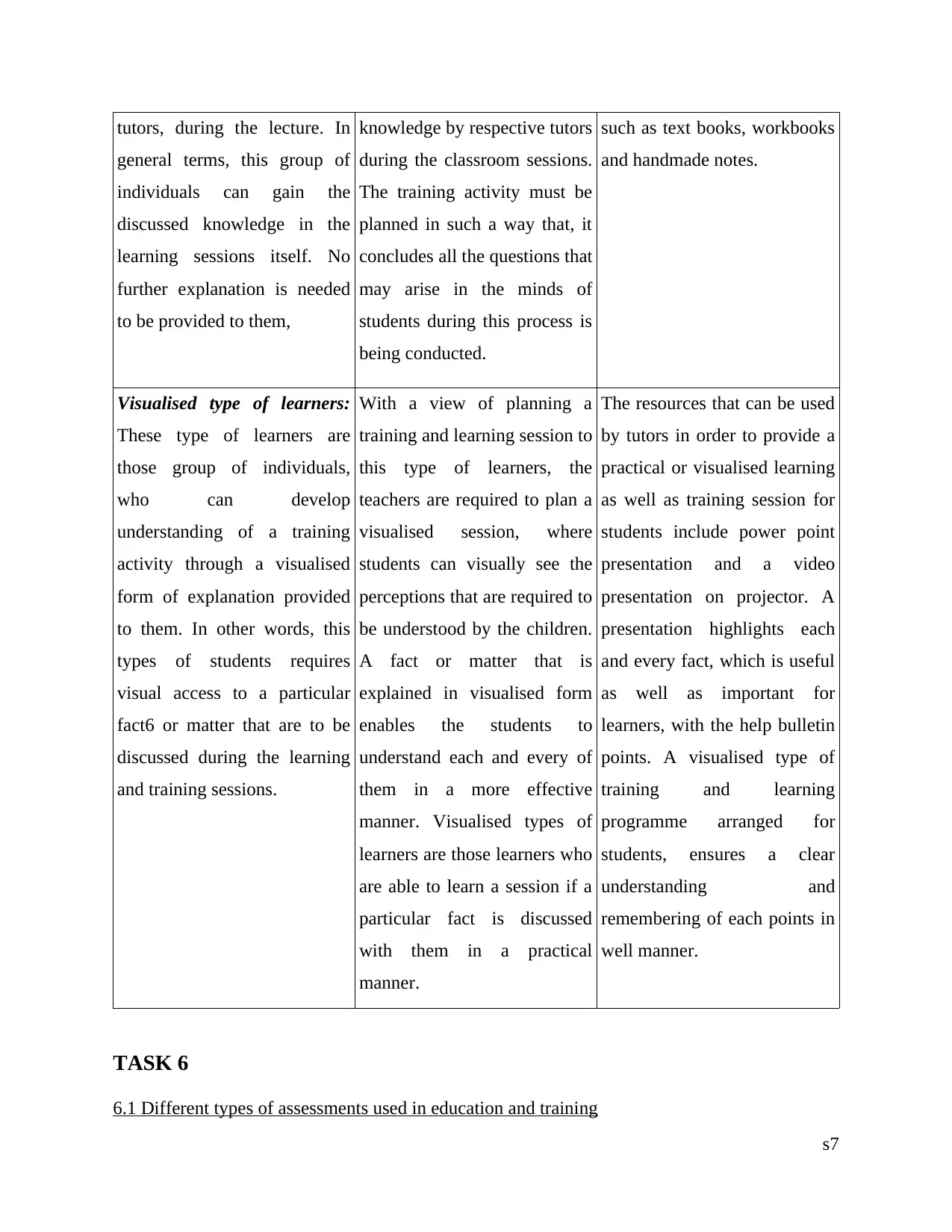
tutors, during the lecture. In
general terms, this group of
individuals can gain the
discussed knowledge in the
learning sessions itself. No
further explanation is needed
to be provided to them,
knowledge by respective tutors
during the classroom sessions.
The training activity must be
planned in such a way that, it
concludes all the questions that
may arise in the minds of
students during this process is
being conducted.
such as text books, workbooks
and handmade notes.
Visualised type of learners:
These type of learners are
those group of individuals,
who can develop
understanding of a training
activity through a visualised
form of explanation provided
to them. In other words, this
types of students requires
visual access to a particular
fact6 or matter that are to be
discussed during the learning
and training sessions.
With a view of planning a
training and learning session to
this type of learners, the
teachers are required to plan a
visualised session, where
students can visually see the
perceptions that are required to
be understood by the children.
A fact or matter that is
explained in visualised form
enables the students to
understand each and every of
them in a more effective
manner. Visualised types of
learners are those learners who
are able to learn a session if a
particular fact is discussed
with them in a practical
manner.
The resources that can be used
by tutors in order to provide a
practical or visualised learning
as well as training session for
students include power point
presentation and a video
presentation on projector. A
presentation highlights each
and every fact, which is useful
as well as important for
learners, with the help bulletin
points. A visualised type of
training and learning
programme arranged for
students, ensures a clear
understanding and
remembering of each points in
well manner.
TASK 6
6.1 Different types of assessments used in education and training
s7
general terms, this group of
individuals can gain the
discussed knowledge in the
learning sessions itself. No
further explanation is needed
to be provided to them,
knowledge by respective tutors
during the classroom sessions.
The training activity must be
planned in such a way that, it
concludes all the questions that
may arise in the minds of
students during this process is
being conducted.
such as text books, workbooks
and handmade notes.
Visualised type of learners:
These type of learners are
those group of individuals,
who can develop
understanding of a training
activity through a visualised
form of explanation provided
to them. In other words, this
types of students requires
visual access to a particular
fact6 or matter that are to be
discussed during the learning
and training sessions.
With a view of planning a
training and learning session to
this type of learners, the
teachers are required to plan a
visualised session, where
students can visually see the
perceptions that are required to
be understood by the children.
A fact or matter that is
explained in visualised form
enables the students to
understand each and every of
them in a more effective
manner. Visualised types of
learners are those learners who
are able to learn a session if a
particular fact is discussed
with them in a practical
manner.
The resources that can be used
by tutors in order to provide a
practical or visualised learning
as well as training session for
students include power point
presentation and a video
presentation on projector. A
presentation highlights each
and every fact, which is useful
as well as important for
learners, with the help bulletin
points. A visualised type of
training and learning
programme arranged for
students, ensures a clear
understanding and
remembering of each points in
well manner.
TASK 6
6.1 Different types of assessments used in education and training
s7
⊘ This is a preview!⊘
Do you want full access?
Subscribe today to unlock all pages.

Trusted by 1+ million students worldwide
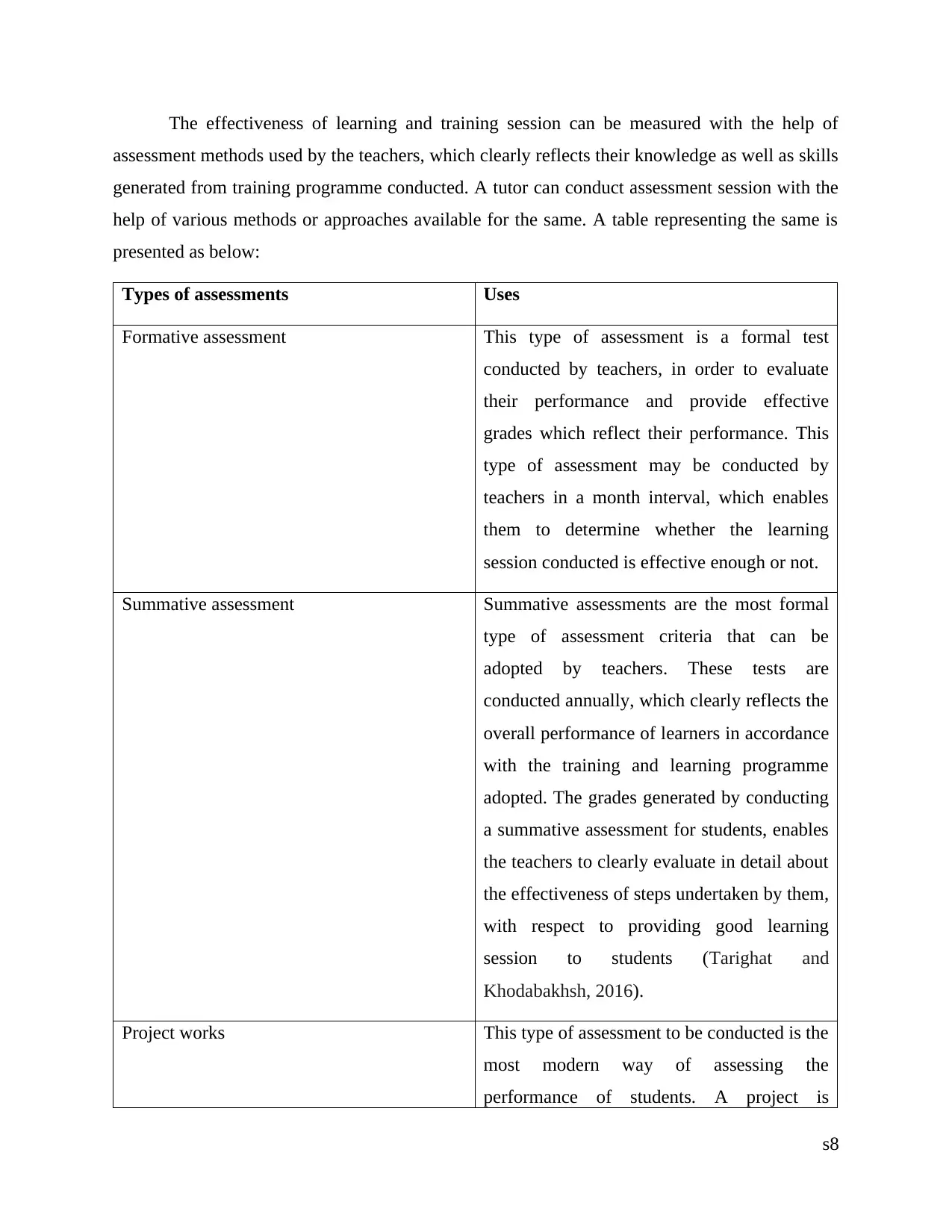
The effectiveness of learning and training session can be measured with the help of
assessment methods used by the teachers, which clearly reflects their knowledge as well as skills
generated from training programme conducted. A tutor can conduct assessment session with the
help of various methods or approaches available for the same. A table representing the same is
presented as below:
Types of assessments Uses
Formative assessment This type of assessment is a formal test
conducted by teachers, in order to evaluate
their performance and provide effective
grades which reflect their performance. This
type of assessment may be conducted by
teachers in a month interval, which enables
them to determine whether the learning
session conducted is effective enough or not.
Summative assessment Summative assessments are the most formal
type of assessment criteria that can be
adopted by teachers. These tests are
conducted annually, which clearly reflects the
overall performance of learners in accordance
with the training and learning programme
adopted. The grades generated by conducting
a summative assessment for students, enables
the teachers to clearly evaluate in detail about
the effectiveness of steps undertaken by them,
with respect to providing good learning
session to students (Tarighat and
Khodabakhsh, 2016).
Project works This type of assessment to be conducted is the
most modern way of assessing the
performance of students. A project is
s8
assessment methods used by the teachers, which clearly reflects their knowledge as well as skills
generated from training programme conducted. A tutor can conduct assessment session with the
help of various methods or approaches available for the same. A table representing the same is
presented as below:
Types of assessments Uses
Formative assessment This type of assessment is a formal test
conducted by teachers, in order to evaluate
their performance and provide effective
grades which reflect their performance. This
type of assessment may be conducted by
teachers in a month interval, which enables
them to determine whether the learning
session conducted is effective enough or not.
Summative assessment Summative assessments are the most formal
type of assessment criteria that can be
adopted by teachers. These tests are
conducted annually, which clearly reflects the
overall performance of learners in accordance
with the training and learning programme
adopted. The grades generated by conducting
a summative assessment for students, enables
the teachers to clearly evaluate in detail about
the effectiveness of steps undertaken by them,
with respect to providing good learning
session to students (Tarighat and
Khodabakhsh, 2016).
Project works This type of assessment to be conducted is the
most modern way of assessing the
performance of students. A project is
s8
Paraphrase This Document
Need a fresh take? Get an instant paraphrase of this document with our AI Paraphraser
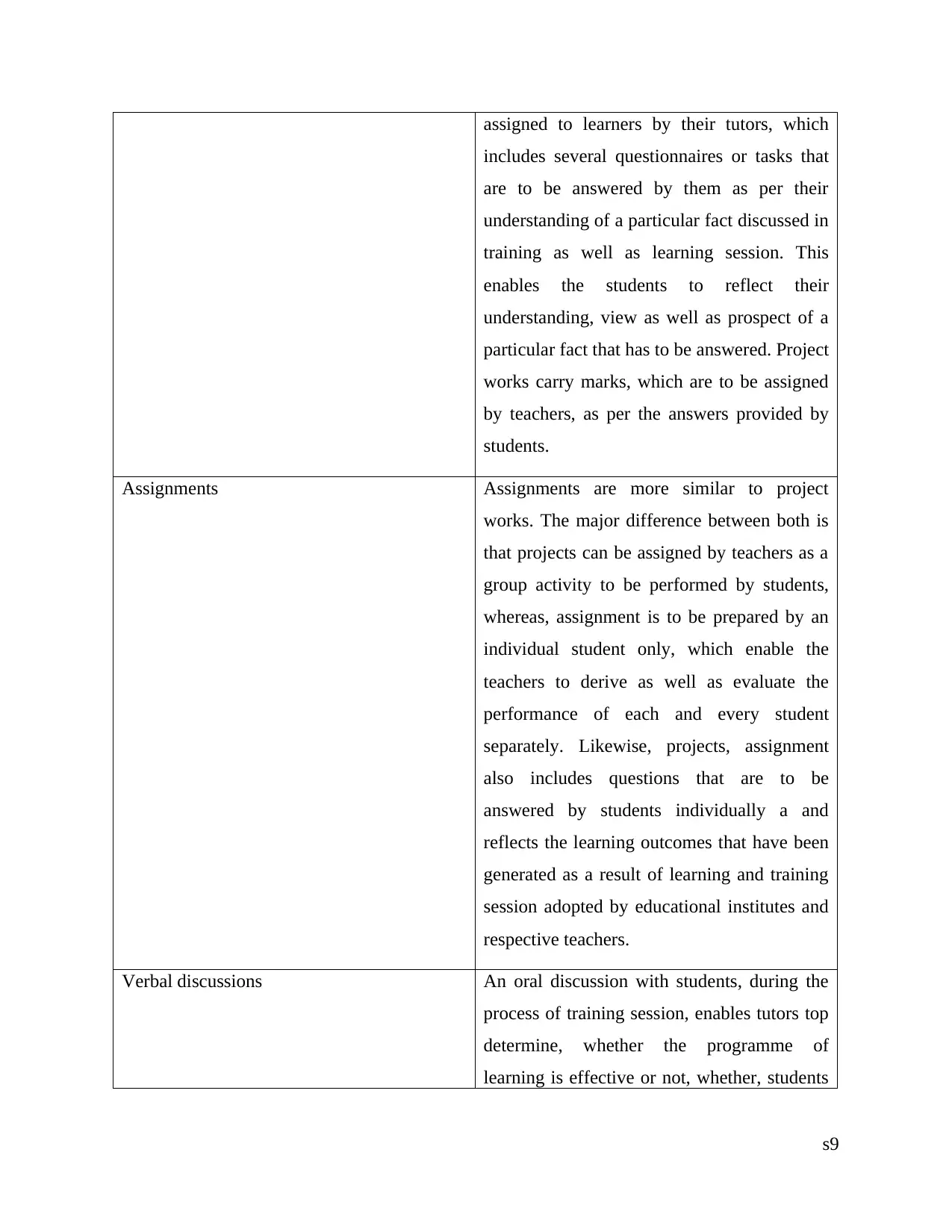
assigned to learners by their tutors, which
includes several questionnaires or tasks that
are to be answered by them as per their
understanding of a particular fact discussed in
training as well as learning session. This
enables the students to reflect their
understanding, view as well as prospect of a
particular fact that has to be answered. Project
works carry marks, which are to be assigned
by teachers, as per the answers provided by
students.
Assignments Assignments are more similar to project
works. The major difference between both is
that projects can be assigned by teachers as a
group activity to be performed by students,
whereas, assignment is to be prepared by an
individual student only, which enable the
teachers to derive as well as evaluate the
performance of each and every student
separately. Likewise, projects, assignment
also includes questions that are to be
answered by students individually a and
reflects the learning outcomes that have been
generated as a result of learning and training
session adopted by educational institutes and
respective teachers.
Verbal discussions An oral discussion with students, during the
process of training session, enables tutors top
determine, whether the programme of
learning is effective or not, whether, students
s9
includes several questionnaires or tasks that
are to be answered by them as per their
understanding of a particular fact discussed in
training as well as learning session. This
enables the students to reflect their
understanding, view as well as prospect of a
particular fact that has to be answered. Project
works carry marks, which are to be assigned
by teachers, as per the answers provided by
students.
Assignments Assignments are more similar to project
works. The major difference between both is
that projects can be assigned by teachers as a
group activity to be performed by students,
whereas, assignment is to be prepared by an
individual student only, which enable the
teachers to derive as well as evaluate the
performance of each and every student
separately. Likewise, projects, assignment
also includes questions that are to be
answered by students individually a and
reflects the learning outcomes that have been
generated as a result of learning and training
session adopted by educational institutes and
respective teachers.
Verbal discussions An oral discussion with students, during the
process of training session, enables tutors top
determine, whether the programme of
learning is effective or not, whether, students
s9
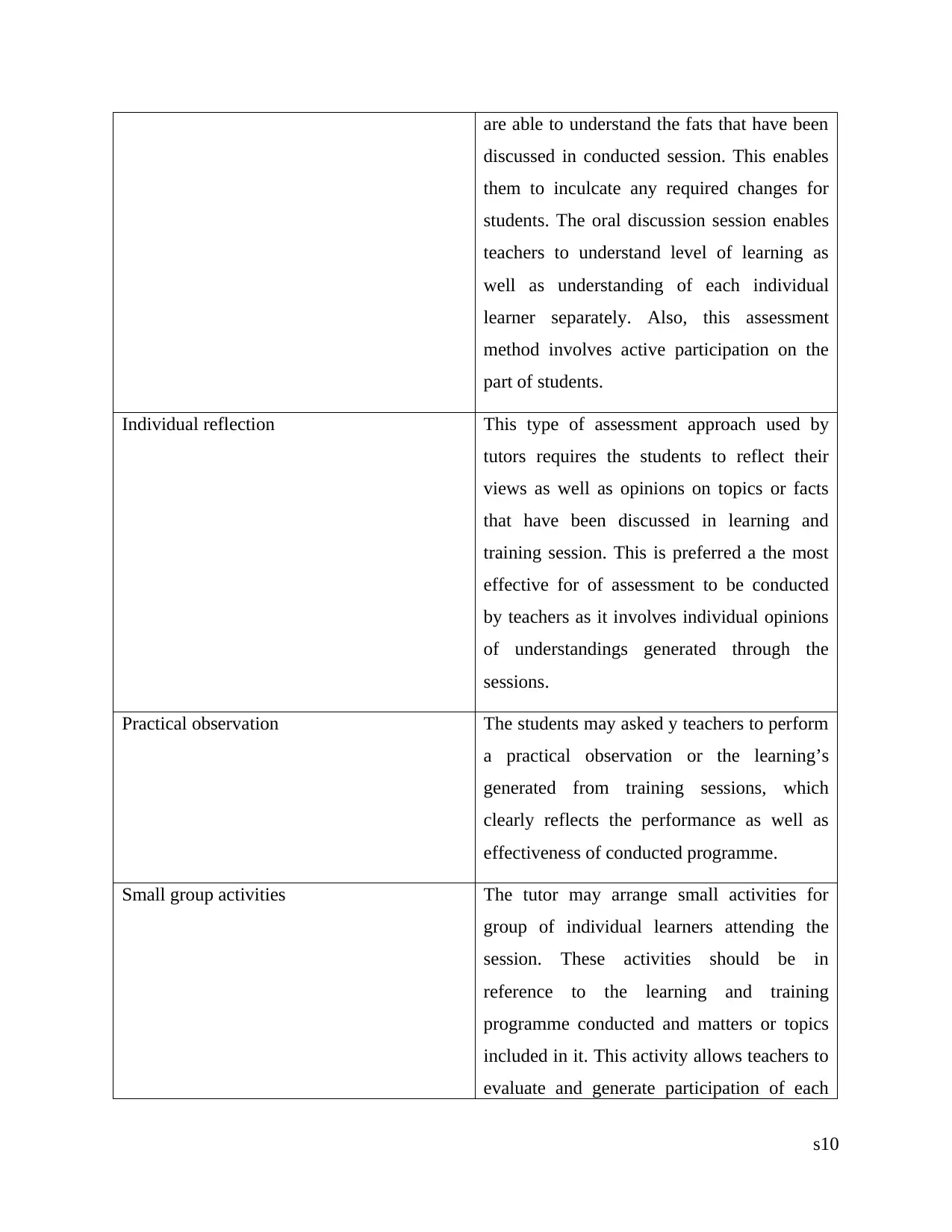
are able to understand the fats that have been
discussed in conducted session. This enables
them to inculcate any required changes for
students. The oral discussion session enables
teachers to understand level of learning as
well as understanding of each individual
learner separately. Also, this assessment
method involves active participation on the
part of students.
Individual reflection This type of assessment approach used by
tutors requires the students to reflect their
views as well as opinions on topics or facts
that have been discussed in learning and
training session. This is preferred a the most
effective for of assessment to be conducted
by teachers as it involves individual opinions
of understandings generated through the
sessions.
Practical observation The students may asked y teachers to perform
a practical observation or the learning’s
generated from training sessions, which
clearly reflects the performance as well as
effectiveness of conducted programme.
Small group activities The tutor may arrange small activities for
group of individual learners attending the
session. These activities should be in
reference to the learning and training
programme conducted and matters or topics
included in it. This activity allows teachers to
evaluate and generate participation of each
s10
discussed in conducted session. This enables
them to inculcate any required changes for
students. The oral discussion session enables
teachers to understand level of learning as
well as understanding of each individual
learner separately. Also, this assessment
method involves active participation on the
part of students.
Individual reflection This type of assessment approach used by
tutors requires the students to reflect their
views as well as opinions on topics or facts
that have been discussed in learning and
training session. This is preferred a the most
effective for of assessment to be conducted
by teachers as it involves individual opinions
of understandings generated through the
sessions.
Practical observation The students may asked y teachers to perform
a practical observation or the learning’s
generated from training sessions, which
clearly reflects the performance as well as
effectiveness of conducted programme.
Small group activities The tutor may arrange small activities for
group of individual learners attending the
session. These activities should be in
reference to the learning and training
programme conducted and matters or topics
included in it. This activity allows teachers to
evaluate and generate participation of each
s10
⊘ This is a preview!⊘
Do you want full access?
Subscribe today to unlock all pages.

Trusted by 1+ million students worldwide
1 out of 22
Related Documents
Your All-in-One AI-Powered Toolkit for Academic Success.
+13062052269
info@desklib.com
Available 24*7 on WhatsApp / Email
![[object Object]](/_next/static/media/star-bottom.7253800d.svg)
Unlock your academic potential
Copyright © 2020–2025 A2Z Services. All Rights Reserved. Developed and managed by ZUCOL.



